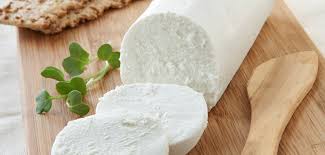Goat cheese

overall fat contents.[1] However, the higher proportion of medium-chain fatty acids such as caproic, caprylic and capric acid in goat's milk contributes to the characteristic tart flavor of goat's milk cheese. (These fatty acids take their name from the Latin for goat, capra.)[2]
Goat cheese has been made for thousands of years, and was probably one of the earliest made dairy products. In the most simple form, goat cheese is made by allowing raw milk to naturally curdle, and then draining and pressing the curds. Other techniques use an acid (such as vinegar or lemon juice) or rennet to coagulate the milk. Soft goat cheeses are made in kitchens all over the world, with cooks hanging bundles of cheesecloth filled with curds in the warm kitchen for several days to drain and cure. If the cheese is to be aged, it is often brined so it will form a rind, and then stored in a cool cheese cave for several months to cure.
Goat cheese softens when exposed to heat, although it does not melt in the same way many cow cheeses do. Firmer goat cheeses with rinds are sometimes baked in an oven to create a softer more viscous texture.